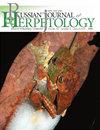侏儒蜥蜴的鳞片显微结构:系统发育稳定性和生态可塑性
IF 0.9
4区 生物学
Q3 ZOOLOGY
引用次数: 6
摘要
皮肤作为身体与外界的界面,直接受到环境的影响。我们研究了澳大利亚Pygopodidae科无肢蜥蜴鳞片表面的微观结构以及皮肤感觉器官(SSO)的数量分布和形态。我们已经证明,毛状感觉器官作为复杂的形态结构,是地鼠鳞片被膜的一个稳定特征。这一特征反映了它们与壁虎的关系,并与一些鬣蜥科(Dactyloidae、Leiosauridae、Opluridae、Chamaeleonidae)具有同源性。与此同时,鳞片微纹饰作为一种基本的形态结构更具可塑性,尽管基本的棘状图案占主导地位,但其他变体也出现在蟒蛇体的鳞片上。我们认为MiO的小刺和SSO的毛在细胞水平上是同源结构,因为它们都是Oberhäutchen细胞表面的衍生物。我们建议将gekkotan和鬣蜥的毛发SSO表征为Oberhäutchen毛感觉器官(ObHSO)。在Gekkota和几个Iguania科的珠被中,SP MiO的主导地位和ObHSO的存在,以及SP MiO在珠舌分类群中的零星出现,为将这些特征视为类同形态提供了理由。我们将蟒蛇头部鳞片中SSO的高丰度(迭代状态)描述为“过度迭代”现象,在这种现象中,对生物体的功能需求增强了系统发育建立的条件。本文章由计算机程序翻译,如有差异,请以英文原文为准。
Scale Microstructures of Pygopodid Lizards (Gekkota: Pygopodidae): Phylogenetic Stability and Ecological Plasticity
The skin, as the interface of the body with the outside world, is directly exposed to the impacts of the environment. We have examined the microstructure of scale surfaces and the numerical distribution and morphology of skin sensory organs (SSO) in Australian limbless lizards of the family Pygopodidae. We have shown that the hairy sensory organs, as complex morphological structures, are a stable characteristic of the scale integument of pygopodids. This feature reflects their relationship to geckos and is shared homoplastically with some iguanian families (Dactyloidae, Leiosauridae, Opluridae, Chamaeleonidae). At the same time, scale micro-ornamentation as an elementary morphological structure is more plastic and, although the basic spinulate pattern is dominant, other variants occur on the scales of the serpentine body of pygopodids. We accept the spinules of MiO and the hairs of SSO as homologous structures at the cellular level since they are both derivatives of the Oberhäutchen cell surface. We propose to characterize the hair-bearing SSO of gekkotan and iguanian lizards as Oberhäutchen hairy sensory organs (ObHSO). Domination of SP MiO and presence of ObHSO in the integument of Gekkota and several families of Iguania, and sporadic occurrence of SP MiO in autarchoglossan taxa provide justification for regarding these characters as plesiomorphic. We characterize the high abundance (iterative state) of SSO in the scales of the head of pygopodids as representing the phenomenon of «overiteration», in which the phylogenetically established condition is enhanced by functional demands on the organism.
求助全文
通过发布文献求助,成功后即可免费获取论文全文。
去求助
来源期刊

Russian Journal of Herpetology
ZOOLOGY-
CiteScore
1.70
自引率
0.00%
发文量
29
期刊介绍:
Russian Journal of Herpetology is an international multi-disciplinary journal devoted to herpetology. Russian Journal of Herpetology accepts original papers on ecology, behavior, conservation, systematics, evolutionary morphology, paleontology, physiology, cytology and genetics of amphibians and reptiles.
Types of Contributions:
-original papers
-invited or contributed reviews on specific topics
-short communications on topics of immediate interest, new methods and ideas in progress
-notices of meetings, symposia, and short courses
-book reviews
 求助内容:
求助内容: 应助结果提醒方式:
应助结果提醒方式:


